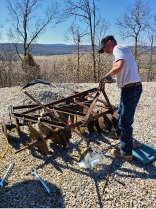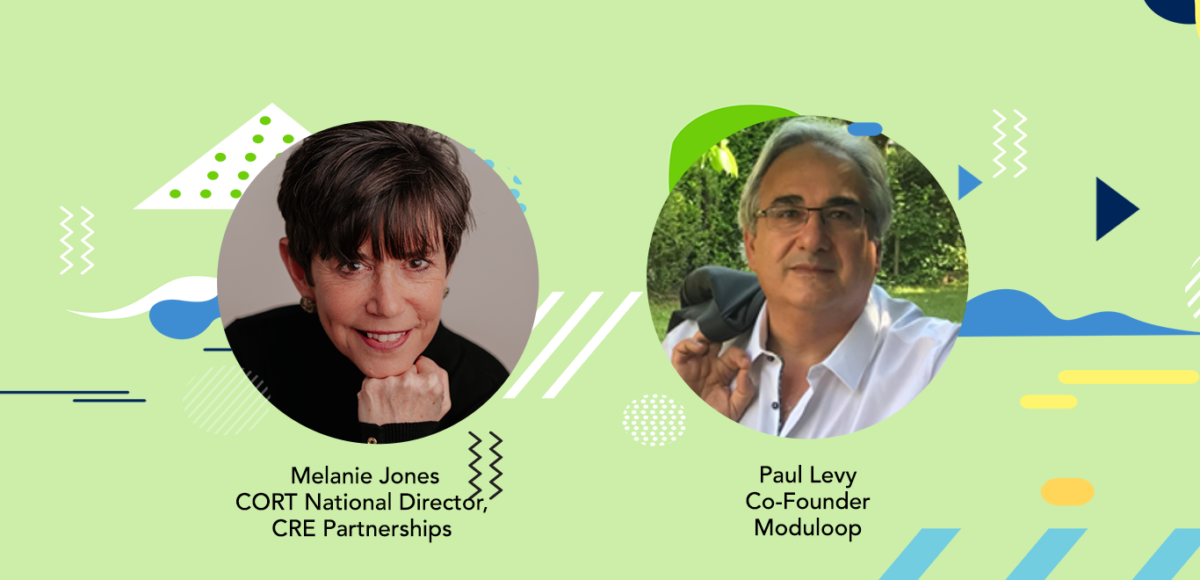 I live on a tree farm in Western Kentucky, where we raise and sell Chestnut trees to other landowners. We do everything we can to incorporate sustainability into our lives and the farming operation.
I live on a tree farm in Western Kentucky, where we raise and sell Chestnut trees to other landowners. We do everything we can to incorporate sustainability into our lives and the farming operation.
My husband, pictured here, is repairing, and restoring a broken farm implement he recently purchased from an equipment yard where it sat idle, rusting away. Now we can reuse it. It’s a small thing, but as more and more of us think this way, we create change. Participating in a circular economy is something all of us can do to help reduce the throwaway society.
As we peer forward in time, it’s evident that we need to make some changes in the thought process of how and when we add products, and goods into our lives and even examine habitual routines. The Amazonization of everything has made it so easy to search, click and order most anything without regard to various environmental and social impacts and outcomes.
When we slow down for a moment and contemplate the outcomes of our decisions, we ask questions like: “do I really need this? do I already have something that will suffice? can I find access to this instead of purchasing, is it available as a second hand or repaired item, can I find a “greener” product or solution and a million other self-examining scenarios. This is the essence of circularity and increased sustainability.
One of the things that I enjoy most about working for CORT is the mission we have to support clients as they leverage our circular and sustainable model for furniture. As a self-described Furniture-as-a-Service “activist,” I speak to many leaders around the globe who feel the same urgency to drive positive transformation in the workplace and the planet.
Melanie Jones: Paul, let’s start with a brief definition of a circular economy. A quick Google search serves up this brief explanation. “A circular economy is “a model of production and consumption, which involves sharing, leasing, reusing, repairing, refurbishing, and recycling existing materials and products as long as possible”.
I love the informational video, mentioned above, but I also love this quote from your website: “Office spaces bear in their DNA their future destruction.” I believe solving this dilemma is core to your mission.
Paul Levy: Absolutely. I’ve been in the industry for over 30 years, lived in several countries, and witnessed tremendous change. I regularly watched companies move every five to seven years and go through the constant destruction of panel systems, furniture, carpet, equipment, etc. The norm is the wasteful manufacturing, utilization, and destruction cycle. I started thinking about how I could create change.
The primary way companies change their workspace is to get rid of everything. As a global society, we must create new types of products. Products that last longer can be repaired, reused, and eventually recycled. It’s starting to happen but slowly. Increasing circularity is something we can implement immediately and begin making a difference.
JONES: I agree. I’ve heard you talk about migration from a linear model to a circular one. Why is this critical?
LEVY: One important reason is that more and more people want and even demand change to our wasteful ways. I’m finding people, companies, investors all want to know the environmental impact of their decisions.
JONES: It is encouraging to watch change occur as people use new and different criteria to make decisions.
LEVY: It’s just starting, really, but workplace decisions are now being made not solely on price, lead times, or style but also around flexibility, changeability, and environmental responsibility.
It’s personal; people and companies want to know the environmental impact of their decisions. These wants will evolve into demands in the very near future.
JONES: I believe when desired outcomes become personal, when the people making decisions care and understand the impact of a decision, we will see change!
Are you working primarily in the workplace? How is the landscape changing in France?
LEVY: An office lease in France is usually for three, six, or nine years and the expectation is the space will be left in its original condition. Of course, this means all the furniture and fixtures must be removed and probably put in the trash.
We are working to provide a full-service “reusable” solution for landlords on one side of the business. We start with furniture, that’s easy, and everyone can understand it, but eventually, everything; carpet, moveable walls, pods, and so forth become a service and we maintain it. This makes it easy for the landlord and their tenant, but more importantly, it helps stay circular and to reuse components in the office over and over again,
We also are helping firms coming out of co-working or smaller firms in growth mode who want a tailor-made location. These firms stay a few years, and the next company will need 80% of the same furniture, carpet, and equipment. Working with our model, we can make that happen, and this helps reduce cost, provide speedy transitions in a space, incorporate sustainability, and most importantly, not throw it away!
JONES: It provides a way for all involved to tap into the circular economy. More and more people and companies know they need to lean towards an “access” instead of an ownership approach but often, don’t know how to. The offerings from both of our companies provide an easy button of sorts.
Not too long ago, I had the privilege of joining Pontus Kihlman and diving pretty deep into this topic. The webinar captures ideas of how to incorporate circularity into the workplace – here’s a link to Furniture-as-a-Service & Circular Economy Webinar for those who are interested.
Participating in global conversations on this topic is rewarding to me. It’s fair to say that other parts of the world are leading the charge in efforts to increase circularity. So learning, ideating, and collaborating with Eeva Terva of Martela Group and Pontus, both in Norway, was inspiring.
By the way, for those who don’t yet follow Pontus on LinkedIn, I encourage doing so. He constantly shares amazingly innovative ideas and continuously challenges the status quo of–well–everything!
LEVY: I think concepts such as a Sharing Economy, Functionality Economy, and Subscription Economy are with us permanently.
JONES: 100%. In your conversations, do you see different motives for investigating these models? Perhaps one company prefers a sustainable approach, another is interested in flexibility, and another is looking to reduce capital?
LEVY: How can anyone know what will happen in the next six or twelve months? We are helping clients with pilots to figure out what they and the employees want.
JONES: So Moduloop acts as an agent of change by facilitating a furniture lease, maintenance, and upkeep while relying on a financing partner. Is that right?
That’s different from our CORT model, where we purchase our furnishing and provide on-demand access to our customers. Once the furniture has completed its life in our rental cycle, we transfer it to our CORT Furniture Outlet centers where it’s sold to the public.
LEVY: Yes, our approach is slightly different as we offer a catalog of choices. Almost like a fleet of cars. We can’t provide everything, or we’ll not be able to refurbish and reuse economically.
Our team then uses a mood board to gather what the customer wants or needs and follow up with a design, the test fit, recommended product, and equipment. We offer this as a serviced offering with all-in cost provided as a monthly subscription. Depending on the situation it’s a fee per month or cost per square meter.
You’ve said the nature of construction seems to be to destroy itself. In your country, it’s interesting to see advancements like the new Right To Repair law, anti-waste, and formulation of the Repair Index.
LEVY: The Repair Index was primarily designed for electronics, but it is a good start, although we now need it for things like furniture. The conversation needs to be about repairing, not just recycling! It’s exciting to think of the new types of training and future jobs in an emerging repair industry.
We are working now with an eco-responsible prepaid tax on furniture. It’s not the government but a government-approved organization. Recycling is good, but now we must lean into transforming and reusing!
Our goal is to help increase flexibility in the workplace while offering sustainable options. It’s not just about CapEx or OpEx. Money is always a driver of the equation, but we can now change the total impact of how the decisions are achieved.
If a tenant makes a purchase, moves out in three years, and the next tenant doesn’t want the furniture, or the landlord requires one to remove what was purchased, you have to consider what happens next. The cycle of destruction starts again.
JONES: Along those lines, we are talking to several US landlords testing flexible space configurations. Evaluation is underway on things like available lease terms for a tenant, the amount of flexibility incorporated into an office lease, a furnished space vs. an unfurnished one, a furniture subscription (access) vs. purchase (ownership), etc.
For example, the purchase option may be more favorable in a pure cost comparison. The evaluation usually compares access vs. ownership based on 100% utilization of the seats and furniture.
Well, guess what! What tips the scale is when a furnished space sits empty month after month, or the new tenant does not want the furniture selected by the landlord, or a commitment to sustainability is part of the firm’s mantra. Then we see a change of strategy by the landlord in favor of a more profitable, sustainable subscription approach to incorporate flexibility and on-demand FF&E. As you said, the service part of the furniture plays a more significant role.
LEVY: Yes, that makes sense. I mean, flexibility should mean you can change. But that change shouldn’t mean waste. It should mean sharing, reuse, and circular. It should mean you aren’t locked into decisions. We will get there; it’s just a matter of time.
JONES: Thank you, Paul. Together we create a better future where less goes into landfills and more respect is given to manufactured products to extend their life and usability.






